-
Up to 70 percent of Northeast U.S. coast likely to adapt to rising seas
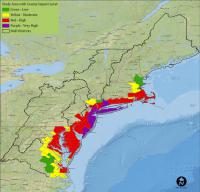
Much of the coast from Maine to Virginia is more likely to change than to simply drown in response to rising seas during the next seventy years or so, according to a new study led by the U.S. Geological Survey. The study is based on a new computer model that captures the potential of the Northeast coast to change, driven by geological and biological forces, in ways that will reshape coastal landscapes.
-
-
Helping policymakers plan for sea level rise
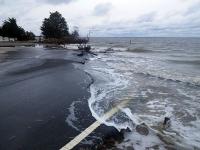
A new study could help protect more than thirteen million American homes that will be threatened by rising sea levels by the end of the century. It is the first major study to assess the risk from rising seas using year 2100 population forecasts for all 319 coastal counties in the continental U.S. Previous impact assessments use current population figures to assess long-term effects of coastal flooding. The data can help policymakers develop practical adaptation strategies for protecting land threatened by frequent and repeated inundation.
-
-
Social media used to assess damage caused by natural disasters
A new study concludes that it is possible to determine the damage caused by a natural disaster in just a few hours by using data from social networks. “Twitter, the social network which we have analyzed, is useful for the management, real-time monitoring and even prediction of the economic impact that disasters like Hurricane Sandy can have,” says one of the researchers.
-
-
Radioactive strontium, cesium from Fukushima continue to leak to the ocean
Scientists investigated the levels of radioactive strontium and cesium in the coast off Japan in September 2013. Radioactive levels in seawater were 10 to 100 times higher than before the nuclear accident, particularly near the facility, suggesting that water containing strontium and cesium isotopes was still leaking into the Pacific Ocean.
-
-
News coverage of Fukushima disaster inadequate
Five years after the 2011 Fukushima Daiichi nuclear disaster in Japan, the disaster no longer dominates U.S. news headlines, although experts say it is a continuing disaster with broad implications. A new analysis finds that U.S. news media coverage following the disaster minimized health risks to the general population.
-
-
The lasting legacies of Chernobyl and Fukushima
It is thirty years since the Chernobyl nuclear disaster. It is also five years since the Fukushima disaster. Greenpeace says that to mark these anniversaries, it has commissioned reviews of scientific studies examining the continued radioactive contamination in the affected areas, and the health and social effects on the impacted populations.
-
-
New laser-based aircraft tracking system to aid in disaster relief efforts
A ground-breaking tracking system called HYPERION, based on eye-safe lasers, could enable aircraft, unmanned aerial vehicles (UAVs), and even orbiting satellites to transmit vital data to ground stations more securely, quickly and efficiently. HYPERION, offering major benefits compared with the traditional radio frequency (RF) data transmission systems currently relied on in the UAV sector, could allow UAVs engaged in disaster monitoring, surveying, search and rescue, and other humanitarian missions to send detailed images more rapidly back to the ground for analysis.
-
-
Sea level rise threatens more people than earlier estimated
It is estimated that 1.9 billion inhabitants, or 28 percent of the world’s total population, live closer than 100 km from the coast in areas less than 100 meters above the present sea level. By 2050 the number of people in that zone is predicted to increase to 2.4 billion. These people are the most vulnerable to the rise of the sea level as well as to the increased number of floods and intensified storms.
-
-
Global warming increases rainfall in world's driest areas
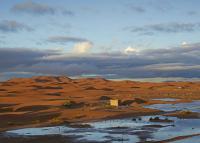
Global warming will increase rainfall in some of the world’s driest areas over land, with not only the wet getting wetter but the dry getting wetter as well — a phenomenon that could lead to more flash flooding.
-
-
Are America's cities prepared for extreme weather events?
Infrastructure is, by design, largely unnoticed until it breaks and service fails. It is the water supply, the gas lines, bridges and dams, phone lines and cell towers, roads and culverts, train lines and railways, and the electric grid; all of the complex systems that keep our society and economy running. Engineers typically design systems to withstand reasonable worst-case conditions based on historical records; for example, an engineer builds a bridge strong enough to withstand floods based on historical rainfall and flooding. But what happens when the worst case is no longer bad enough?
-
-
Seeding iron on the Pacific’s floor may not pull carbon from air as thought
Scientists plumbing the depths of the central equatorial Pacific Ocean have found ancient sediments suggesting that one proposed way to mitigate climate warming — fertilizing the oceans with iron to produce more carbon-eating algae — may not necessarily work as envisioned.
-
-
Syria’s 1998-2012 drought likely its most severe in more than 900 years
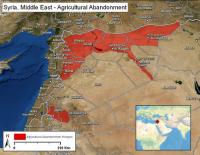
In the years before the Syrian conflict erupted, the region’s worst drought on record set in across the Levant, destroying crops and restricting water supplies in the already water-stressed region. A new study shows that that drought, from 1998 to 2012, was not just the most severe in a century of record-keeping — it was the Levant’s most severe drought in at least 500 years and likely more than 900 years.
-
-
All of Indonesia’s Tsunami early warning buoys were inoperable before 7.8 magnitude tremor
At the time of the 7.8-magnitude earthquake which struck off the Indonesian coast on Wednesday night, all of Indonesia’s tsunami early warning buoys were inoperable. The shallow tremor 600 km off Sumatra island did not generate a tsunami, but the incident has raised questions about the effectiveness of the early warning system, which was deployed in the wake of the devastating 2004 tsunami.
-
-
All of Indonesia’s Tsunami early warning buoys were inoperable before 7.8 magnitude tremor
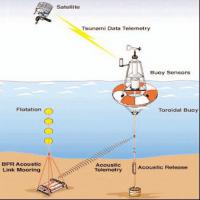
At the time of the 7.8-magnitude earthquake which struck off the Indonesian coast on Wednesday night, all of Indonesia’s tsunami early warning buoys were inoperable. The shallow tremor 600 km off Sumatra island did not generate a tsunami, but the incident has raised questions about the effectiveness of the early warning system, which was deployed in the wake of the devastating 2004 tsunami.
-
-
Outbreaks of extreme tornados have become more common
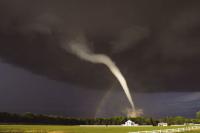
Most death and destruction inflicted by tornadoes in North America occurs during outbreaks — large-scale weather events that can last one to three days and span huge regions. The largest outbreak ever recorded happened in 2011. It spawned 363 tornadoes across the United States and Canada, killing more than 350 people and causing $11 billion in damage. A new study shows that the average number of tornadoes per outbreak has grown by more than 40 percent over the last half century. The likelihood of extreme outbreaks — those with many tornadoes — is also greater.
-
- All
- Regional
- Water
- Biometrics
- Borders/Immig
- Business
- Cybersecurity
- Detection
- Disasters
- Government
- Infrastructure
- International
- Public health
- Public Safety
- Communication interoperabillity
- Emergency services
- Emergency medical services
- Fire
- First response
- IEDs
- Law Enforcement
- Law Enforcement Technology
- Military technology
- Nonlethal weapons
- Nuclear weapons
- Personal protection equipment
- Police
- Notification /alert systems
- Situational awareness
- Weapons systems
- Sci-Tech
- Sector Reports
- Surveillance
- Transportation
Advertising & Marketing: advertise@newswirepubs.com
Editorial: editor@newswirepubs.com
General: info@newswirepubs.com
2010-2011 © News Wire Publications, LLC News Wire Publications, LLC
220 Old Country Road | Suite 200 | Mineola | New York | 11501
Permissions and Policies
Editorial: editor@newswirepubs.com
General: info@newswirepubs.com
2010-2011 © News Wire Publications, LLC News Wire Publications, LLC
220 Old Country Road | Suite 200 | Mineola | New York | 11501
Permissions and Policies
